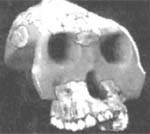The missing link
 scientists working in a remote part of Ethiopia have unearthed the remains of a new species of an ape-like animal that lived around 2.5 million years ago, and some stone tools. They say the tools were possibly used by the first human ancestor to prepare meat , a dramatic evidence of butchery being one of the oldest professions. What could be described as a "missing link' in the evolution of human beings can be bridged if the claim made by the scientists is proved.
scientists working in a remote part of Ethiopia have unearthed the remains of a new species of an ape-like animal that lived around 2.5 million years ago, and some stone tools. They say the tools were possibly used by the first human ancestor to prepare meat , a dramatic evidence of butchery being one of the oldest professions. What could be described as a "missing link' in the evolution of human beings can be bridged if the claim made by the scientists is proved.
Anthropologists involved in the study believe the ability to use tools to prepare meat and crush bones could have provided the burst in nutrition necessary for the development of larger brains in early human ancestors. Tim White, a biologist at the University of California in Berkeley, usa, who led the research group, said the invention of tools to butcher the animals would have led to unprecedented access to a high-fat diet of meat and marrow, necessary for brain development.
The new hominid species, called Australopithecus garhi , had a brain capacity of about 450 cubic centimetres, compared with the 1,400 cubic centimetres of modern humans, and lived in East Africa between two and three million years ago, a crucial period in evolution just before the emergence of the human family. "You go into this period with bipedal, big-toothed chimps and come out with meat-eating, large brained hominids. That is a big change in a relatively short time. We would really like to know more about what happened there,' said White. Three independent discoveries were made by the researchers outside the small village of Bouri, northeast of Addis Ababa.
They found part of the skull of Australopithecus garhi , which enabled the scientists to classify it as new species, and the leg and the arm bones of the second individual, which lived at the same time and is likely to belong to the same species.
The third find, just a few feet away, from the skeletal remains, included the bones of antelopes, horses and other animals, which showed clear signs of having been butchered with stone tools. Some of the bones were crushed or broken off at both ends, indicating the extraction of marrow. Others had curved cut marks, including some found on an antelope's jawbone, presumably to remove the tongue.
This is the first evidence of stone tools being used for butchering animals, although such tools from that period have been discovered earlier, said White. "Marrow is rich in fat, and few animals, other than humans and hyenas can get at it. Anthropologists have theorised that such a dietary breakthrough allowed the dramatic increase in brain size,' say the scientists.
Related Content
- Order of the National Green Tribunal regarding large scale felling of toddy yielding palm trees in Bihar, 05/06/2025
- State of global environmental governance 2023
- Bracing for superbugs: strengthening environmental action in the one health response to antimicrobial resistance
- Order of the National Green Tribunal regarding discolouration of seawater near Surathkal beach in Dakshina Kannada district, Karnataka, 18/11/2022
- Joint committee report on pollution of Phalguni river, Dakshina Kannada, Karnataka, 11/10/2022
- Regulatory review of the electricity market in Africa: towards crowding-in private sector investment
